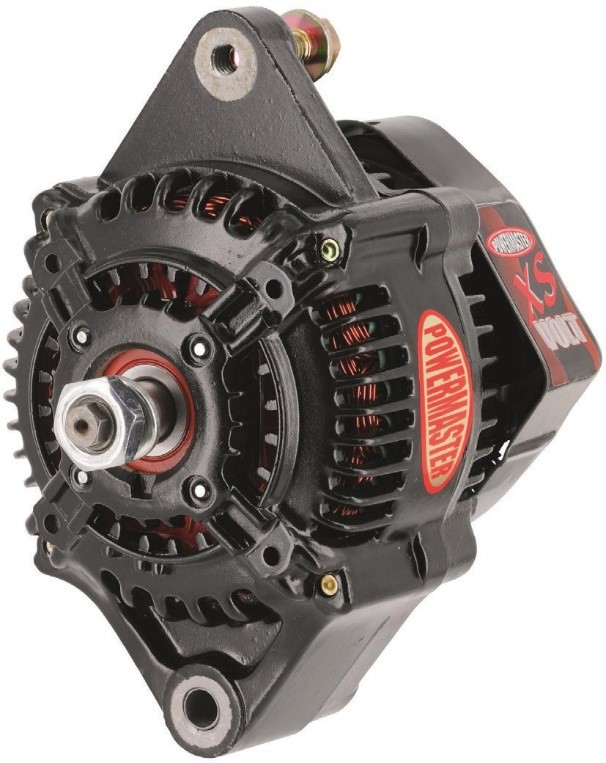Often taken for granted and rarely inspected, the charging system in today’s modern performance vehicle is responsible for keeping the battery fully charged and supplying the proper amount of voltage to the electrical system. This sounds relatively simple, yet whether it’s a daily driver, pickup truck, or pure-bred race car, charging system problems are often unpredictable and when they occur, can quickly cause a myriad of issues, from dimming lights to even a stalled engine and dead battery.
The common 12-volt automotive charging system consists of an alternator, battery, charge wiring and ammeter/voltmeter gauge or indicator light. While most late model vehicles have the voltage regulator built into the alternator, many early models located the regulator externally, mounted either on the firewall or inner fender well. The “heart” of the system is the alternator, which includes the rotor, stator, rectifier, and voltage regulator. Fastened directly to the alternator pulley, the rotor spins within the fixed stator assembly, producing Alternating Current (AC), similar to the power used in homes.
The AC is then converted to Direct Current (DC) through a series of diodes that are specially arranged within the rectifier. At the same time, the voltage regulator maintains the DC at 13.5-14.8 volts as it is fed via the charge wire to the battery and throughout the electrical and charging system, ensuring that all system components function correctly.
When selecting an alternator for the charging system, it is important to know that the chosen unit offers sufficient amperage for the intended application. J.R. Richmond, technical representative for Powermaster Performance, states that “some enthusiasts may err and choose a unit with insufficient amperage, not realizing that all of their accessories add up quickly and subsequently, it can’t meet their requirements”. After choosing the proper alternator, it should be rigidly mounted to the engine, properly grounded, and fit with the correct diameter pulley so that it will operate effectively within its specified power curve.
The experts at Powermaster recommend that circle track applications use a pulley ratio of 1:1, while drag racers need approximately 1.75:1 and street-driven vehicles require 3:1-3.5:1. Powermaster offers a full line of high-performance alternators including the top-of-the-line, “XS Volt”. Richmond says that the XS Volt units are particularly suited to racing as they “may be custom tailored to the application, regardless whether the system uses a 12-, 14- or 16-volt battery”.
The alternator drive belt must match the pulley for correct type (V-belt, serpentine, or HTD), width and length, and be tightened properly so that it does not slip. To ensure that the belt is tight enough, apply a 1/2” breaker bar with the necessary socket on the nut that secures the alternator pulley and attempt to rotate the pulley in a clockwise rotation. If the engine begins to turn over and the belt does not slip, the belt is tightened sufficiently.
Richmond says that one of the most common pitfalls of charging systems is using an alternator charge wire that is of insufficient size. This is of concern on race cars where the battery has been relocated to the rear of the vehicle, requiring a longer and heavier gauge wire than would be required for a front-mounted battery. Basic automotive electric wiring principles require that wire diameter be increased when length is extended or amperage is increased. If the charge wire is of insufficient size, it can cause a condition referred to as “voltage drop”, according to Richmond.
The condition can often become the source of a hard to diagnose electrical “gremlin”, caused when the wire is overloaded and subsequently overheats, leading to system shorts or even potentially causing a fire. All charge wire terminals should be crimped and soldered to ensure positive connections. PowerMaster Performance provides helpful charge wire sizing recommendations in their tech help section.
The battery also plays an important part in the equation. Richmond states that “the battery’s job is to store power and act as a distribution center”. If battery condition is in question, it can be quickly checked using a battery load tester. If the battery requires charging, care should be taken to ensure that the charger is truly compatible with the battery.
With the availability of lead-acid, gel, AGM, and lithium-ion models, mismatching batteries and chargers is a relatively recent problem that can significantly shorten battery life. Braille, Lithium Pros, Odyssey, Optima, Turbo Start, and XS Power are good sources for high-performance batteries and chargers. Battery cable lengths should be as short and direct possible, using four-gauge if the battery is located in the stock underhood position, while two- or zero-gauge is preferred if the battery has been relocated to the trunk. QuickCar offers a full selection of premium battery cable and highly conductive, gold-plated battery terminals when an upgrade is desired.
The system may be closely monitored using a permanently installed voltmeter. Available from vendors including QuickCar, Allstar Performance, and Auto Meter, a voltmeter provides instant notice to the driver in the event of a problem, while also aiding system diagnosis.
Often ignored or overlooked until there’s a problem, the key to reliable charging system performance is not only choosing the correct, quality components, but also ensuring that the associated wiring is correctly sized, installed, and terminated.

Powermaster’s XS Volt Unique Voltage Control System
The XS Volt is a powerful internal voltage regulating system that is suited to a wide variety of racing or high-performance street applications. Alternators with this feature offer true one-wire operation and full digital control. Regulator response time occurs in milliseconds rather than in seconds as with traditional analog regulators. The user adjustable voltage feature allows voltage to be set between 13.5-18.5 volts, allowing full compatibility with 12-, 14-, or 16-volt electrical systems. Denso-style alternators allow increasing voltage by simply turning the adjustment screw counter-clockwise, while GM/Delco units require clockwise rotation. The adjustment screw is simply turned in the opposite direction to decrease voltage. The XS Volt is also ideal for lithium battery applications that require low-voltage setpoints.